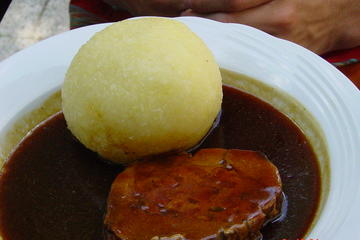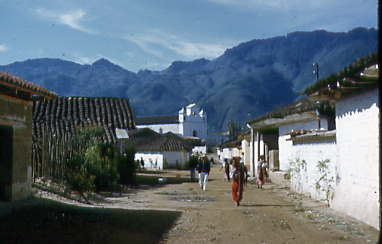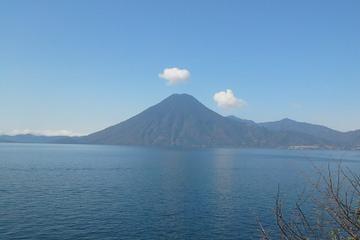
As an avid art lover, I have always been captivated by the transformative power of creativity. There’s something truly magical about stepping into a world where imagination knows no bounds and emotions come alive on canvas or in sculpture. And when it comes to experiencing the pinnacle of artistic treasures, there is no place quite like Paris. The City of Lights holds an unrivaled reputation as the mecca for art enthusiasts. It boasts an extraordinary collection of museums and galleries that span centuries of artistic expression. Join me on an enchanting journey as we unravel the best museums and galleries to visit in Paris—where the past merges with the present, and every stroke of a brush tells a remarkable story.
Louvre Museum: A Journey through Time and Beauty
Stepping into the Louvre Museum is like embarking on a time-traveling adventure where history and beauty intertwine. As I entered the grandiose halls, I couldn’t help but feel a surge of anticipation, knowing that I was about to witness some of the world’s most iconic masterpieces. The vastness of the Louvre is awe-inspiring, housing an unparalleled collection that spans civilizations and continents. The sheer magnitude of the art on display is staggering, but I was determined to seek out the gems that have captivated art enthusiasts for centuries. Standing face to face with the enigmatic Mona Lisa, I marveled at the subtle details and the mysterious smile that has intrigued generations.
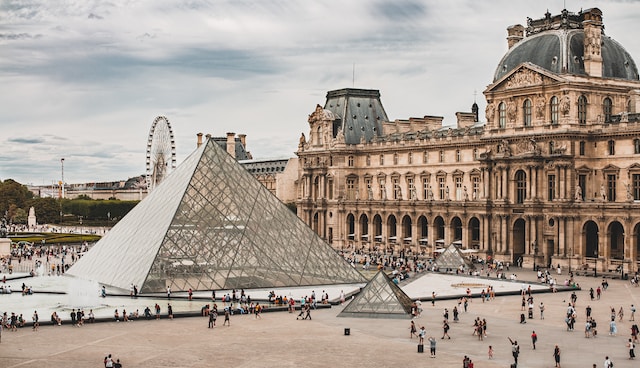
However, the Louvre is not just about famous works. It is a labyrinth of artistic wonders waiting to be discovered. I stumbled upon the mesmerizing Winged Victory of Samothrace, an ethereal marble sculpture that seemed to defy gravity, evoking a sense of triumph and grace.
This place is a testament to humanity’s creative genius and a voyage through time that no art lover should miss. Prepare to be spellbound. Wander through its corridors and encounter treasures that have shaped the course of art history and left an indelible mark on our collective imagination.
Musée d’Orsay: Where Impressionism Shines
This former railway station turned art haven is a symphony of colors and emotions that will leave you in a state of pure artistic bliss. From the moment I entered, I felt a palpable energy, as if the brushstrokes of Monet, Renoir, and Van Gogh were alive and dancing before my eyes. The Musée d’Orsay is a paradise for admirers of this groundbreaking artistic movement. Prepare to be swept away by the enchanting world of Impressionism as you immerse yourself in a gallery filled with sun-drenched landscapes, ethereal ballerinas, and soul-stirring portraits. Do yourself a favor; grab your beret and get ready to be inspired by the sheer brilliance of Impressionism at the Musée d’Orsay.
Centre Pompidou: Modern Art Unleashed
If you’re looking for the best museums and galleries to visit in Paris, this one might take the cake (oh, and Père-Lachaise cemetery)! This architectural marvel looks like a vibrant technicolor spaceship that has landed in the heart of Paris, announcing the arrival of a new era in art. As I entered, I could feel the pulsating energy of modernity coursing through my veins. The Centre Pompidou is a playground for those who dare to think differently and embrace the unconventional. Its thought-provoking exhibits and mind-bending installations challenge the very definition of art. It leaves you with a sense of exhilaration and sheer wonder. From abstract paintings that seem to defy logic to interactive sculptures that blur the line between art and audience, this is a place where creativity knows no bounds.
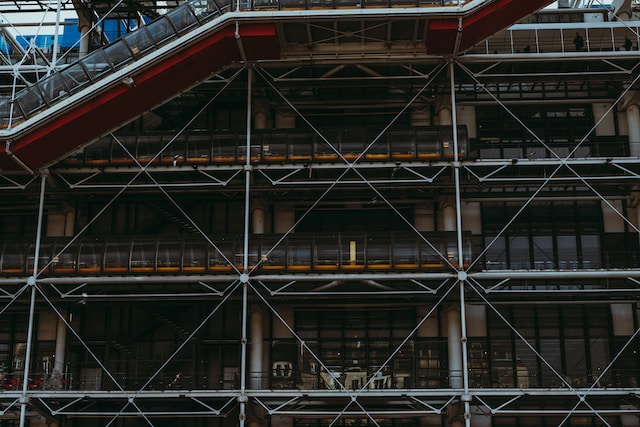
Musée de l’Orangerie: Monet’s Water Lilies and Beyond
Step into a serene oasis of artistic enchantment at the Musée de l’Orangerie, where Monet’s magnificent Water Lilies take center stage. It’s a feast for the eyes, a kaleidoscope of colors that transports you into a world of tranquility and beauty. I got lost in the ethereal strokes, mesmerized by the play of light and the reflection of nature’s harmony. It’s a haven for Impressionist and Post-Impressionist art, housing an array of captivating works by Renoir, Cézanne, and Modigliani. The intimate setting adds a touch of intimacy. Plus, it allows you to immerse yourself fully in the artistic expressions of these brilliant minds. Our friends at Mod Movers share, “You’d be surprised by the number of people relocating to Paris for art.”
Picasso Museum: Tracing the Artistic Evolution
The one and only. The legend. Pablo Picasso. Witness the artistic evolution of a genius as you explore his diverse periods and styles, from the Blue Period to Cubism and beyond. Stand in awe before his bold brushstrokes and imaginative compositions that forever changed the course of art history—I know I did. Housed in the magnificent Hôtel Salé, this museum pays homage to Picasso’s boundless creativity—and insatiable artistic curiosity. Engage with his innovative and influential artworks that continue to inspire and challenge the boundaries of art. Get ready to be mesmerized by the artistic genius of Picasso at every turn.

Musée de l’Art Moderne: Parisian Avant-Garde
Prepare to be dazzled by the vibrant avant-garde art scene at the Musée de l’Art Moderne in Paris. Immerse yourself in a world where tradition merges with innovation and classic meets contemporary. Explore the works of iconic artists like Modigliani and Chagall, whose creations challenge conventions and ignite the imagination. From striking paintings to thought-provoking installations, this museum is a testament to Paris’s artistic vitality and creative spirit. Personally, I found their exhibitions and events simply exhilarating. The Musée de l’Art Moderne is a playground for those seeking artistic enlightenment and a fresh perspective on the ever-evolving landscape of modern art.
Final destination: Musée de l’Art Contemporain
Out of all the museums and galleries to visit in Paris, this one’s a must-stop. This is where art takes a daring leap into the unknown, pushing boundaries and redefining what we thought was possible. As I ventured through its doors, I found myself face to face with thought-provoking installations that challenged my perception of reality. Each artwork seemed to defy conventions, urging me to question and explore the depths of my own imagination. From multimedia creations to interactive exhibits, this museum celebrates the diversity and experimental nature of contemporary art. You will be captivated, inspired, and transformed by the captivating world of contemporary art at the Musée de l’Art Contemporain.
About the author:
Jakob O’Connor is a passionate freelance writer and intrepid traveler with an insatiable curiosity for the world. With a pen in one hand and a passport in the other, he weaves captivating stories that transport readers to far-flung destinations and inspires them to embark on their own adventures.
Browse Paris Tours Now Available
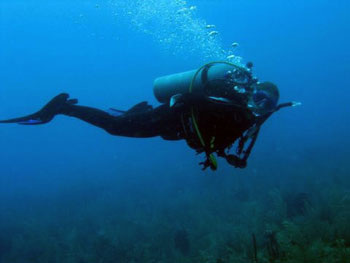
 Utila sits atop the second largest fringe reef in the world, and is one of the cheapest places to become a certified diver. Divers from all over the world flock to the island in hopes of spotting an elusive whale shark. Doran, who works at a dive shop on Utila, recently certified her 100th open water diver. In the future she hopes to work for Sea|mester, a semester-long program that teaches students sailing, diving, and marine biology. We discussed the practicalities of becoming a dive instructor to find out how a dream job can become a reality.
Utila sits atop the second largest fringe reef in the world, and is one of the cheapest places to become a certified diver. Divers from all over the world flock to the island in hopes of spotting an elusive whale shark. Doran, who works at a dive shop on Utila, recently certified her 100th open water diver. In the future she hopes to work for Sea|mester, a semester-long program that teaches students sailing, diving, and marine biology. We discussed the practicalities of becoming a dive instructor to find out how a dream job can become a reality. TD: I’m a PADI instructor, and have been a part of the PADI system since my own open water course. Therefore, the information that I provide is pretty specific to PADI which has 80 % of the world diving market share.
TD: I’m a PADI instructor, and have been a part of the PADI system since my own open water course. Therefore, the information that I provide is pretty specific to PADI which has 80 % of the world diving market share.
 TD: I get paid to scuba dive. And when I’m not getting paid, I still get to dive for free. I get to travel anywhere in the world that caters to divers, and have a good chance of being employed once I get there. This opens up exotic locations in Indonesia, the Indian Ocean, the Red Sea, the Caribbean, and the Pacific.
TD: I get paid to scuba dive. And when I’m not getting paid, I still get to dive for free. I get to travel anywhere in the world that caters to divers, and have a good chance of being employed once I get there. This opens up exotic locations in Indonesia, the Indian Ocean, the Red Sea, the Caribbean, and the Pacific. TD: Diving is not for everyone. Unless you’re working at a year-round diving destination, the business is likely to be seasonal at best. Working at a year-round diving destination also tends to bring people far from their homes and families.
TD: Diving is not for everyone. Unless you’re working at a year-round diving destination, the business is likely to be seasonal at best. Working at a year-round diving destination also tends to bring people far from their homes and families.

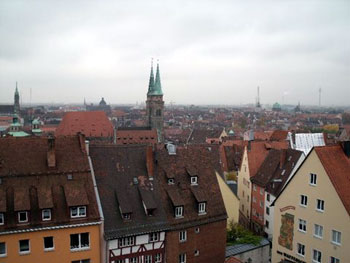

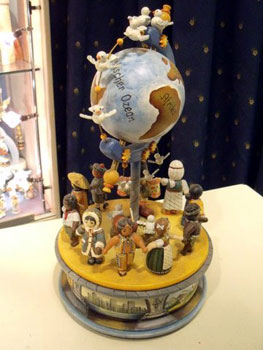 How did the largest chain of stores in the world selling traditional German Christmas items come to fruition? You can thank the military police as the reason. Circa 1963, IBM worker Wilhelm Wohlfahrt went door to door around the military installation in Boblingen trying to sell some music boxes made in Erzgebirge (in Saxony). He had only wanted to buy one originally for his friends, but was forced to buy a lot of ten from a wholesaler, so he wanted to unload the rest to recoup his money. He was found out and foiled by the military police since this activity was illegal. They suggested to him that he sell them at weekend craft shows on base instead, and the rest is history.
How did the largest chain of stores in the world selling traditional German Christmas items come to fruition? You can thank the military police as the reason. Circa 1963, IBM worker Wilhelm Wohlfahrt went door to door around the military installation in Boblingen trying to sell some music boxes made in Erzgebirge (in Saxony). He had only wanted to buy one originally for his friends, but was forced to buy a lot of ten from a wholesaler, so he wanted to unload the rest to recoup his money. He was found out and foiled by the military police since this activity was illegal. They suggested to him that he sell them at weekend craft shows on base instead, and the rest is history.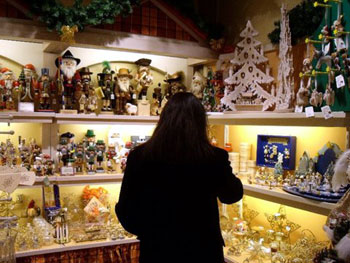 Nuremberg is known for its dockenmacher (dollmakers) dating back to medieval times. Because a nice dollhouse is often on the Christmas wish list of many children. I found the most comprehensive collection of doll houses, dolls, and doll house fixtures at the Spielzeugmusuem. It will astonish you. The older the dolls and their related items, the more detailed they seemed to be. It’s amazing just how much effort the past generations have put into creating such detailed toys, an art that seems to have been generally lost because of the hyper-technological age we live in today. But this is just the tip of the iceberg of what toys you’ll see there, toys that brought back a lot of childhood memories for me.
Nuremberg is known for its dockenmacher (dollmakers) dating back to medieval times. Because a nice dollhouse is often on the Christmas wish list of many children. I found the most comprehensive collection of doll houses, dolls, and doll house fixtures at the Spielzeugmusuem. It will astonish you. The older the dolls and their related items, the more detailed they seemed to be. It’s amazing just how much effort the past generations have put into creating such detailed toys, an art that seems to have been generally lost because of the hyper-technological age we live in today. But this is just the tip of the iceberg of what toys you’ll see there, toys that brought back a lot of childhood memories for me.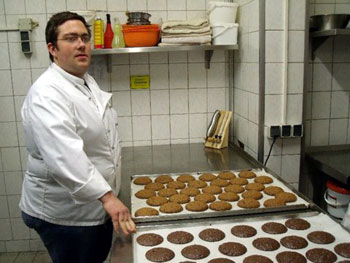 Nuremberg gingerbread (known as lebkuchen) is considered some of the best in the world. Lebkuchen has its roots via the Franconian monks who created honey cakes (pfefferkuchen), of which the sweet nectar was procured from the local bee colonies since it was cheaper to use than imported Asian sugar. But the lebkuchen that we know today goes back around six centuries to 1395, though the first city gingerbread guild didn’t come out until 1643. A law was made requiring sellers to own their own oven and a number of bakers became masters by marrying the daughter of a master baker.
Nuremberg gingerbread (known as lebkuchen) is considered some of the best in the world. Lebkuchen has its roots via the Franconian monks who created honey cakes (pfefferkuchen), of which the sweet nectar was procured from the local bee colonies since it was cheaper to use than imported Asian sugar. But the lebkuchen that we know today goes back around six centuries to 1395, though the first city gingerbread guild didn’t come out until 1643. A law was made requiring sellers to own their own oven and a number of bakers became masters by marrying the daughter of a master baker.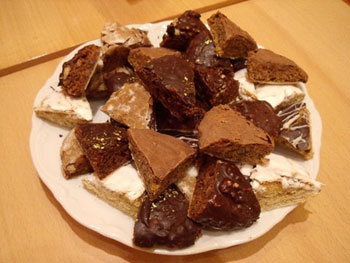 The Neefs use such ingredients like ginger, nutmeg, cinnamon, hazelnuts, vanilla, cloves, honey, lemon peel and orange peel for their base recipe that’s over 500 years old, though they offer 8 kinds during the fall and winter (including one with chocolate). The bakery uses machinery that can produce 2500 mound-like lebkuchen in an hour (compared to individual hand molds that a skilled baker would take 5 hours to shape that same amount by scraping the batter like a brick layer does mortar for bricklaying). I was able to sample some of the raw dough that was dominated by the flavor of orange. It takes 15 minutes at 356 degrees Fahrenheit (180 degrees Centigrade) to bake the lebkuchen, and upon coming out of the oven, it’s a must try, even if you’re on a diet! What I like about the finished goodies is the lightly fruity flavor that’s got a chewy feel to it. The ones with chocolate were especially good.
The Neefs use such ingredients like ginger, nutmeg, cinnamon, hazelnuts, vanilla, cloves, honey, lemon peel and orange peel for their base recipe that’s over 500 years old, though they offer 8 kinds during the fall and winter (including one with chocolate). The bakery uses machinery that can produce 2500 mound-like lebkuchen in an hour (compared to individual hand molds that a skilled baker would take 5 hours to shape that same amount by scraping the batter like a brick layer does mortar for bricklaying). I was able to sample some of the raw dough that was dominated by the flavor of orange. It takes 15 minutes at 356 degrees Fahrenheit (180 degrees Centigrade) to bake the lebkuchen, and upon coming out of the oven, it’s a must try, even if you’re on a diet! What I like about the finished goodies is the lightly fruity flavor that’s got a chewy feel to it. The ones with chocolate were especially good.